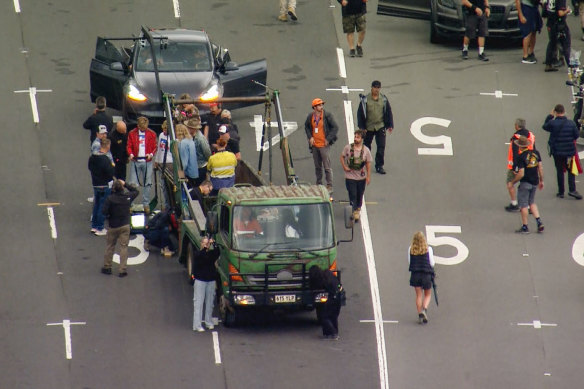Save articles for later
Add articles to your saved list and come back to them any time.
Hollywood studios are among the biggest winners from Labor’s second budget, as they finally secure the increased subsidies they have been pursuing for more than a decade.
The Location Offset, a scheme wherein foreign productions receive a refund on their expenditure in Australia, will increase from 16.5 per cent to 30 per cent from July 1.
Thanks for coming: Nine Perfect Strangers, which counted Nicole Kidman among its big-name cast, was enticed to Australia by the combination of the Location Offset and the Location Incentive.Credit: Amazon Prime Video
The increase to the Location Offset will mean the end of a secondary scheme, the Location Incentive program, which has effectively added an extra 13.5 per cent rebate via cash grants, to bring the total subsidy to foreign productions from Australian taxpayers to 30 per cent.
The industry has long argued that is the minimum figure necessary to ensure Australia is internationally competitive in the lucrative and employment-heavy blockbuster film and TV sector.
The budget papers predict the cost to the government of the Offset increase will be $112.3 million over the next four years. However, analysis by this masthead suggests the actual cost of the uncapped scheme could be much higher if current patterns continue.
The Location Incentive was introduced in July 2019, and as of February 2023, 37 titles had received backing, at a total allocation of $421 million. That’s an average spend of $11.34 million per title, and nine titles per year (funding has also been set aside for additional titles, but not all have yet been announced).
If that level of activity were to be sustained over the next four years, that would equate to $102.06 million per year – almost four times the $28.075 million per year allocated in the budget papers.
Any increase in costs through the new offset will be balanced out by the fact the Location Incentive fund has been discontinued. Slated to run to June 2027, that fund is understood to have exhausted its $540 million allocation already, years ahead of schedule.
The simplicity of applying for the rebate through a single mechanism via the tax system, rather than having to apply to a capped fund administered by the arts minister, also holds appeal to the studios. In theory, they will now have the certainty they need to plan for sustained levels of production in Australia over many years to come.
Kate Marks, chief executive of AusFilm, the agency set up to attract foreign production to Australia, said the increase to the offset “will provide long-term certainty to international clients looking to invest” in the country.
The Sydney Harbour Bridge was closed in January as a scene was shot for the mega-budget Ran Gosling movie The Fall Guy. Credit: Nine News
“International companies can now more easily consider bringing a pipeline of activity to Australia, which will provide more stable and consistent work for Australian workers and businesses,” she said. “We also anticipate that the certainty it provides will encourage more investment into screen infrastructure and training.”
Paul Muller, chief executive of the Australia New Zealand Screen Association, which represents the big five studios (Warner Bros, Universal, Disney, Sony and Paramount) plus Netflix and Village Roadshow, also welcomed the change.
“The Australia New Zealand Screen Association congratulates the Australian Government for recognising how the film, television and streaming industry is a key economic driver which supports jobs, small businesses and tourism,” said Muller. “Increasing the Location Offset will provide certainty and stability, which is needed to develop screen industry capacity that can support a growing sector”.
In February, ANZSA presented a report in Canberra in which was claimed that every dollar spent on supporting foreign production in the country returned $5.89 in economic activity. That report also claimed that an increase to 30 per cent could unlock the development of new studio space in Australia, which would in turn increase activity in the sector.
“There is no doubt that investors … are holding back their plans for new studio provision, urgently needed because of constrained capacity, because of the uncertainty around this particular Offset,” the report claimed.
A year earlier, the then government released modelling of its own that claimed the Location Incentive scheme could support up to $4 billion worth of production activity over its projected lifespan – a return of up to $8.04 for every dollar spent.
The full picture is, however, far more complicated. Those productions already qualified for the 16.5 per cent Offset, and typically would be supported by state agency support of up to 10 per cent. The Gold Coast, where much of the Hollywood production is located, also offers its own city-backed incentives.
All up, with support from all levels of government potentially running at 40 per cent (or more), that looks like a return on investment of something closer to 2.5.
Whatever the figures, though, the simplification of the mechanism means the studios have one less reason not to come here, and one less reason not to invest in the studio space they claim they so desperately need.
Find more of the author’s work here. Email him at [email protected], or follow him on Facebook at karlquinnjournalist and on Twitter @karlkwin.
Find out the next TV, streaming series and movies to add to your must-sees. Get The Watchlist delivered every Thursday.
Most Viewed in Culture
From our partners
Source: Read Full Article




